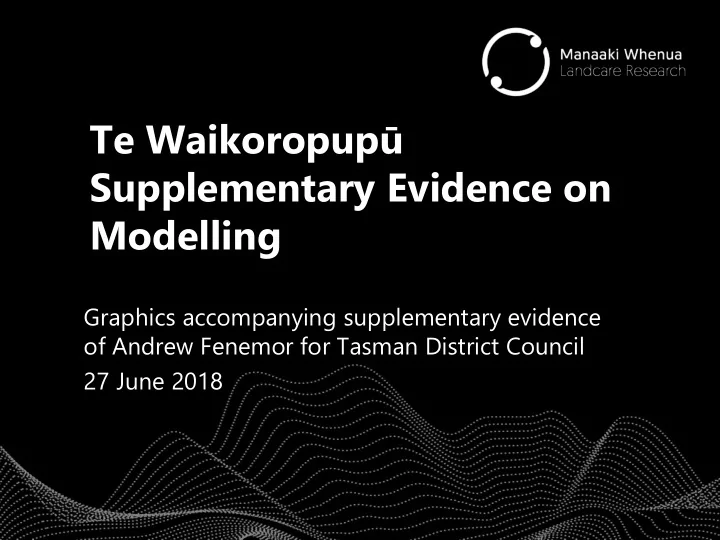

Te Waikoropupū Supplementary Evidence on Modelling Graphics accompanying supplementary evidence of Andrew Fenemor for Tasman District Council 27 June 2018
2 Supplementary Presentation (a) Relevance of modelling evidence (b) Summary of the implications of modelling evidence (c) Critiques of the modelling and why the modelling is fit for purpose (d) The validity of the soil parameters used in the various models (f) Model calibration, reliability and uncertainty and the implications (g) Comments on supplementary evidence of Dr Gamlen and Prof Williams
3 Relevance of modelling evidence • Setting of limits in evidence of Dr Hickey and Dr Young • Modelling future scenarios informs you about – Risks of limits being exceeded – Limitations that chosen limits would impose on community, primary and secondary industry
4 Summary of the implications of modelling evidence • Current development contributes 97% of the nitrate-nitrogen in the TWS spring flow. • All modelled scenarios maintain TWS average nitrate-nitrogen below the upper range trigger of 0.55 g/m 3
Scenario Calculated AMA Fully Mixed 5 Nitrate Concentrations (g/m3) Modelled nitrate from Te Waikoropupū Springs for 7 Current Dairy 0.41 0.44 Current+Proposed 0.47 Current +Proposed+Plausible land use scenarios 0.54 Current+Proposed+Plausible+Unlikely 766 l/sec upper allocation limit from 0.44 FLAG deliberations 0.47 Double current irrigation 0.35 100% dryland dairy 0.002 No Development - AMA recharge zone Nitrate-Nitrogen Concentrations 0.7 0.6 Current 766 l/sec +Proposed+ allocation Plausible limit from Nitrate-nitrogen concentratin (g/m 3 ) 0.5 Current FLAG 100% dryland Dairy Current+Proposed+ Plausible+Unlikely dairy 0.4 Double Current+ current Proposed irrigation 0.3 0.2 0.1 No development (AMA recharge zone) 0.0 0 500 1,000 1,500 2,000 2,500 3,000 3,500 Irrigated area in AMA recharge zone (ha) Main Spring Fish Creek AMA aquifer
6 Critiques of the modelling and why the modelling is fit for purpose • The modelling presents the long-term upper limit of effects, and can be seen as conservative • Good model calibration through the good match between ‘Measured’ and ‘Current state (Calibration)’ values • Modelling is described in detail in Weir & Fenemor 2017 peer reviewed by Dr John Bright and Joseph Thomas
7 The validity of the soil parameters used in the various models • Loss rates of nitrogen from land uses vary with soil water holding capacity (PAW), rainfall and irrigation, plant cover and land use practices such as stocking rates and fertilizer applications Average Land cover or land Reference or Source of Chosen N Loss NO 3 -N loss use class Rates (kg/ha/year) Aqualinc (2014) Table 9, and further 0.65 calibrated to match measured N Forestry concentrations Intensive OVERSEER estimated average for Takaka 106 pasture/dairying valley, 2014-15 (irrigated) OVERSEER estimated average for Takaka Dryland/low 68 intensity pasture valley, 2014-15 Hanson (2010) Tables 1-4, and further Native grassland / 2.5 calibrated to match measured N hill scrubland concentrations
8 Plant Available Water (PAW) values used in eigen-modelling for valley floor soils
9 Mean PAW of three predominant soil series from S-Map superimposed on my original Fig 6: Hamama 66-101mm Takaka 99-105mm Karamea 102-118mm
1 0 Validity of the soil parameters • More detailed S-Map data analysis produces soil PAWs in the AMA recharge zone a little lower than those used in our modelling, but not nearly as low as Mr Thoma has estimated. • Mean PAW values for the Hamama, Takaka and Karamea soils derived from S-Map data were found to be in the range 84- 110mm, compared with 20-39mm calculated by Mr Thoma for a 0.6m plant rooting depth for pasture • Eigen-models were adjusted during calibration to match measured water levels and springflows, so the effects of using slightly higher PAWs are likely to be small. • Variability of annual rainfall is a more major driver of N leaching than soil PAW in the Takaka Valley
1 1 Use of OVERSEER in regulatory processes (from Freeman et al 2016 Using OVERSEER in regulation )
1 2 Model calibration, reliability and uncertainty and the implications • Simple eigen-modelling for flow and mass load modelling for nitrogen were used because of the complexity and uncertainties around hydrology and water quality within the Takaka AMA. • Appendix 1 addressed model reliability and uncertainty for FLAG • Assumes – Fully mixed at TWS : stability of FOGB data supports this – No attenuation (reduction in N by denitrification, biological and chemical degradation) : conservative assumption – Calculated N losses in recharge zone create current N concentrations at TWS : valid if losses 8 years ago were same or more than currently, assuming 8 year average lag time – Dairy farming in valley floor : conservative assumption – 97% valley floor N contribution may be an over-estimate
1 3 Comments on supplementary evidence of Dr Gamlen and Prof Williams • See handout
Recommend
More recommend